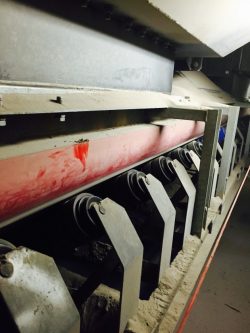Snap-Loc skirting in basalt rock quarry
Details:
| Product: | Snap-Loc™ Dust Seal Skirting System |
| Product Category: | Conveyor Skirting & Sealing |
| Location: | Wyndhamvale, Victoria, Australia |
| CONVEYED MATERIALS: | Basalt Rock - 60mm minus |
| CONVEYOR WIDTH: | 47.24” (1200mm) |
| CONVEYOR RATE: | 650 ton/hr |
| Installation Date: | January 2014 |
Problem Description:
The customer operates quarries and sand pits to extract, sell and distribute quarry products. Ecological Vegetation Classes (EVCs) stipulate that the quarry and its surrounding area is of very high environmental significance and therefore the containment of dust pollution is a priority for this customer, and levels are monitored regularly by the local authorities.
The customer was experiencing a significant spillage problem around the transfer point where three large cone crushers deposited bulk basalt rock onto the conveyor belt. The impact of the load drop created extraordinary air pressure dust blow-outs, forming dense clouds that would disperse heavily throughout the handling area.
During production stoppages, manual resources were required on a frequent basis to shovel clear the area around the chute system. Not only did this create a physical labor OHS issue, but breathing in the airborne particles runs the risk of leading to more grave health issues.
Resolution:
 Since our Australian distributor recommended the use of Snap-Loc™ for this bulk materials handling situation, the customer has been highly impressed with the performance of Snap-Loc due to the following two key reasons:
Since our Australian distributor recommended the use of Snap-Loc™ for this bulk materials handling situation, the customer has been highly impressed with the performance of Snap-Loc due to the following two key reasons:
- Dust Containment: Unlike any type of flat skirting (rubber or polyurethane), the flexibility and inherent “memory set” of Snap-Loc is able to form a subtle curved shape to contain the dust. This concave curve is formed by the light downward pressure of Snap-Loc’s bulb head, designed to be simply installed using a Unistrut mount to the outer structure of the cone crusher, hanging down to “float” on the surface of the belt itself. This tight seal securely captures the pressurized airborne dust particles, without causing any damage to the belt itself.
- Longer Lasting Performance: Being able to effectively contain the small basalt rocks means that these fines do not get lodged between the skirting and the conveyor belt. This was leading to rips or tears in the polyurethane. As a result of the containment, the hardness tolerance of the R69 specified durometer polyurethane is not compromised and the Snap-Loc can perform to its full potential, lasting longer in production.
With the clouds of dust in this confined transfer space now gone, the maintenance cleanup tasks are no longer required, and team members are no longer at risk of the OHS issues. The investment in Snap-Loc also means that not only does production continue with fewer stoppages, but less replacement skirting needs to be purchased in the future.

